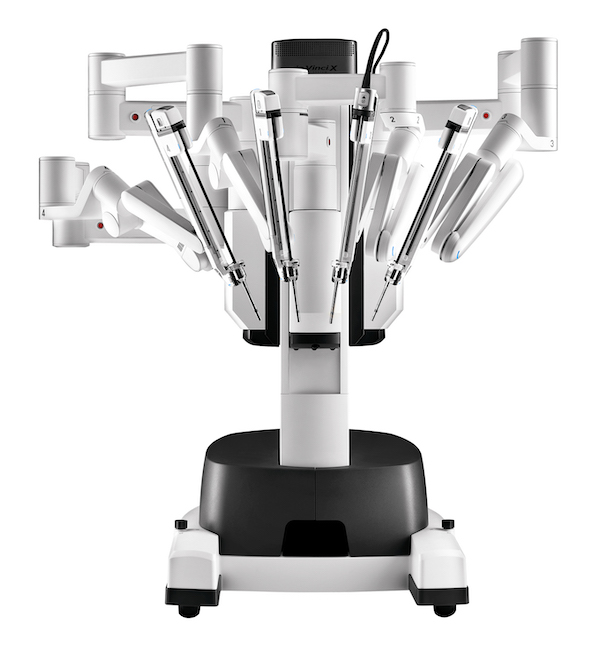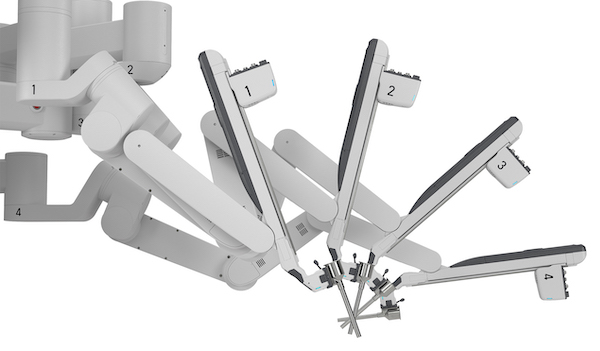Center of Excellence in Robotic Surgery
 Surgeons at Southwest Healthcare Rancho Springs Hospital have performed more than 5,000 robot-assisted surgeries using the da Vinci® Xi™ Robotic Surgical System. This advanced machine gives surgeons more flexibility and precision than ever before. Robotic techniques are used in general, gynecologic and urologic surgery, for procedures such as hysterectomies, nephrectomies (removal of part of, one or both kidneys), prostatectomies (removal of the prostate gland) and removal of the gallbladder.
Surgeons at Southwest Healthcare Rancho Springs Hospital have performed more than 5,000 robot-assisted surgeries using the da Vinci® Xi™ Robotic Surgical System. This advanced machine gives surgeons more flexibility and precision than ever before. Robotic techniques are used in general, gynecologic and urologic surgery, for procedures such as hysterectomies, nephrectomies (removal of part of, one or both kidneys), prostatectomies (removal of the prostate gland) and removal of the gallbladder.
The robotic surgery program at Rancho Springs Hospital is the first in Southwest Riverside County to achieve accreditation from Surgical Review Corporation (SRC) as a Center of Excellence in Robotic Surgery. This accreditation recognizes Rancho Spring’s commitment and high standard of delivery of quality patient care and safety.
Contact Us About Robotic Surgery
If you need a referral to a surgeon or other physician at Rancho Springs Hospital, call our free physician referral service at 1-800-879-1020 or search for a physician online.
Advantages of Minimally Invasive and Robotic Surgery
Both robotic surgery and laparoscopic surgery are known as minimally invasive procedures. In both procedures, small incisions are used, which may result in less post-operative pain, reduced blood loss, less need for blood transfusions and a potentially faster recovery time.* The two major drawbacks of conventional laparoscopy (without the use of robotic instrumentation) are that it relies on the use of rigid, hand-held instruments, and visualization is provided by a standard 2D video monitor rather than a 3D field. While standard laparoscopic surgery is performed using small incisions, the surgeon's depth of field, dexterity and precision may be variable.
Potential benefits of minimally invasive robotic surgery over open surgery include:*
- Shorter hospital stay (one day in most cases versus three to five days)
- Significantly less pain post-operatively (often only over-the-counter pain medications are required)
- Quicker recovery and return to normal activities (one to two weeks versus six to eight weeks)
- Fewer complications and less risk of infection
- Less scarring (small, dime-sized incisions versus a six- to eight-inch scar)
Podcast: Urologic Robotic Surgery
Learn more about how da Vinci robotic surgery at Rancho Springs Hospital has helped our patients return to the activities they enjoy sooner and with less pain in this educational health podcast.
How the da Vinci Xi Robotic Surgical System Works
 Surgeons at Rancho Springs Hospital were the first in the region to use the da Vinci Surgical System. They operate the da Vinci system using a computer console that's located close to the patient. This is how the surgeon controls the machine’s robotic arms. The surgeon finds the optimal position for the procedure using the Xi’s sophisticated targeting system. Once the best area is located, the da Vinci system will configure itself to give the surgeon a greater range of motion. With pinpoint accuracy, the surgeon then uses the robotic arms to make a series of three small incisions, or ports, in the surgical area. The arms are then inserted into the body.
Surgeons at Rancho Springs Hospital were the first in the region to use the da Vinci Surgical System. They operate the da Vinci system using a computer console that's located close to the patient. This is how the surgeon controls the machine’s robotic arms. The surgeon finds the optimal position for the procedure using the Xi’s sophisticated targeting system. Once the best area is located, the da Vinci system will configure itself to give the surgeon a greater range of motion. With pinpoint accuracy, the surgeon then uses the robotic arms to make a series of three small incisions, or ports, in the surgical area. The arms are then inserted into the body.
There is a tiny video camera on one of the arms and the other two arms are equipped with special surgical instruments. The camera gives the surgeon a 3D, high-definition image of the surgical site from inside the patient's body, which they can magnify up to 10 times. The surgeon can take advantage of the enhanced vision and movement of the robotic arms, resulting in a better outcome for the patient.
Patient Success Story: Karole Caldwell
Karole benefited from single site hysterectomy using the da Vinci Surgical System, which requires only one incision in the navel (belly button).
Best Candidates for Robotic Surgery
Not all procedures can be done robotically, and not all patients are candidates for procedures that can be performed robotically. The best candidates for robotic surgery are chosen on an individual basis by your doctor. Ask whether or not your diagnosis and situation will lend itself to robotic surgery.
*Individual results may vary. There are risks associated with any surgical procedure. Talk with your doctor about these risks to find out if robotic surgery is right for you.
